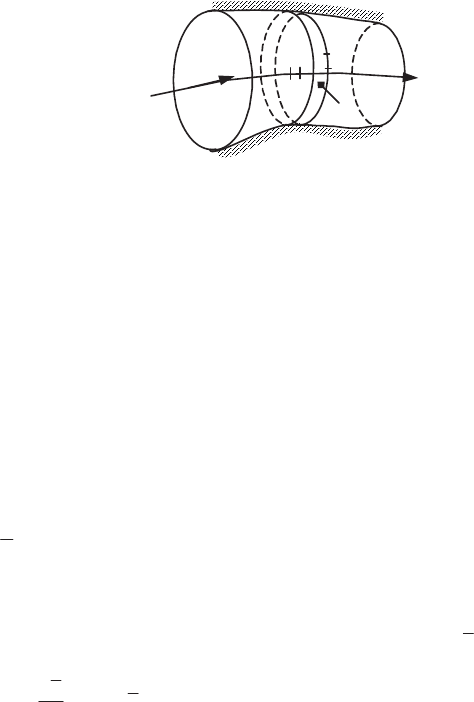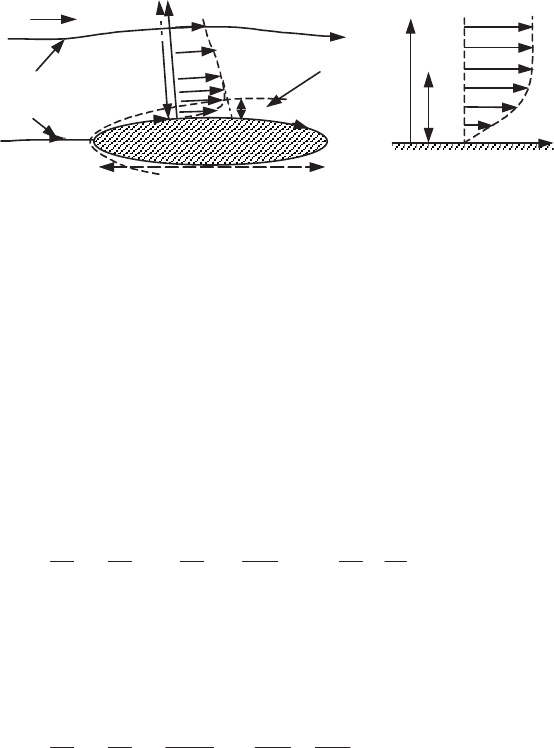Peube J-L. Fundamentals of fluid mechanics and transport phenomena
Подождите немного. Документ загружается.


General Properties of Flows 313
the instant t depends only on data from the past or the upstream region. This
explains the fact that the state of the matter in the cross-section depends on its
anterior state on the trajectory; the diffusion term of quantity G only provides a
limited action in this section, the suppression of the conduction term
xq
Gx
ww
amounting to the suppression of all flux in the upstream direction.
The velocity components u and v are the unknowns of dynamic equation [6.76].
The demonstration of the parabolic character can be effected by introducing the
stream function
\
such that the mass conservation is satisfied:
xvyu ww ww
\
\
Equation [6.76] can thus be written:
3
3
2
222
y
x
p
y
xyxyytdt
du
g
w
w
w
w
»
»
¼
º
«
«
¬
ª
w
w
w
w
ww
w
w
w
ww
w
\
P
\\\\\
UU
[6.79]
In equation [6.79] the derivations with respect to x and t are of order 1, whereas
the derivation with respect to y is of order 3, which indicates the parabolic character
with respect to the variables x and t.
In applications, the hypotheses of section 6.5.1.1 are very often encountered.
Quasi-1D flows can be produced:
when the geometric boundary conditions impose such an evolution: in flows in
pipes this kind of approximation exists for most macroscopic physical phenomena
(electric, electromagnetic, thermal, etc.);
when diffusion phenomena in flows lead to weak fluxes of extensive quantities
in the axial direction Ox compared with the convection fluxes of these. In inviscid
fluids transport or propagation phenomena governed by the characteristics are, in
fact, perturbed by contact actions (viscosity, thermal conduction, diffusion, etc.), and
this leads to a transverse migration of the extensive quantities. The balance
equations contain high-order derivatives which “perturb” the convective transport
terms. In these situations, there exist non-dimensional parameters (Reynolds, Peclet
numbers, etc.) which take on high values.
We will successively examine two categories of problem in which the data are
different.

314 Fundamentals of Fluid Mechanics and Transport Phenomena
6.5.2. Flows in pipes
6.5.2.1. Nature of the problem
A pipe is a stream tube 6 materialized by a wall. The dominant velocity
component u in a cross-section is directed along its axis. The definition of the
problem to solve can be obtained as usual by combining the local balance equations
(mass, axial momentum, energy, etc.) with the initial and usual boundary conditions
on the wall
6
L
.
x
u(x,t)
S(x)
Gx
G
D
6
L
C
d
A
G6
L
Figure 6.16.
Balance in a pipe
The geometric elements of the pipe are given, such that integration of the
dynamic equation leads to a relation between the volume (or mass) flow and a
pressure difference between two cross-sections. Calculation of the velocity
distribution (or of a quantity G) in a cross-section is an internal problem posed in
the interior domain of the stream tube 6 (Figure 6.16).
6.5.2.2.
Global balance equation for an extensive quantity in a pipe
The normal of a cross-section S(x) is here oriented parallel to Ox (orientation by
continuity). This convention requires a change in sign at the time of application of
Osstrogradski’s theorem to a closed surface 6 containing cross-sections. By
assumption, the lateral wall 6
L
is supposed impermeable to the flow, i.e.
0.
³
6
L
dsnVg
G
. Consider the small domain
G
D of the pipe comprised between the
sections of abscissas x and x +
G
x of the lateral surface
G6
L
(Figure 6.16).
Formula [4.62] for the global balance of a volume quantity
g can be written:
dsnqdvdsnugdv
t
g
jGjGii
³³³³
¦6
w
w
q
DD
V
[6.80]

General Properties of Flows 315
Taking account of the preceding assumptions, we have:
³³³³
6 S
GG
xx
x
S
ii
dsxdvgudsdsnug
VGV
G
.;
D
The density flux
G
q
G
is essentially normal to the lateral wall (section 6.5.1.2) for
irreversible changes (viscosity, conduction, diffusion) and the integral
³
6
dsnq
j
Gj
is
equal to
A
dqx
C
Gw
³
.
G
taken over the contour
C
of the cross-section (
q
Gw
is the flux
density of
G
, normal to the wall).
Substituting these expressions into [6.80] and dividing by
G
x
gives:
A
dqdsdsgu
x
ds
t
g
C
GwG
S
³³³³
w
w
w
w
SS
V
[6.81]
In the place of the volume quantity
gg
U
, let us take the massive quantity
g
;
we obtain:
³³³³
w
w
w
w
C
GwG
S
dqdsugds
x
ds
t
g
A
SS
VU
U
[6.82]
The quantity
³³
SS
GS
dsguugds
UM
is the
flow of quantity
G
across the
cross-section
S
.
6.5.2.3.
Applications
Taking 1
g
, we have the
volume flow rate
³
S
vS
udsq
across
S
.
Taking 1
g
, we have the equation for the
mass balance
:
0
w
w
w
w
³
x
q
ds
t
m
S
U
[6.83]
with:
³
S
m
udsq
U
, the mass flow in the rate cross-section
S
.
The
momentum balance
along Ox can be obtained by applying formula [6.82] of
the quantity
g
=
u
. Supposing (section 6.5.1.3) that the driving pressure gradient
xp
g
ww
(here, the term
V
G
) is constant over the cross-section
S
, and designating by
W
w
the
viscous stress exerted by the fluid on the lateral wall
, we have:

316 Fundamentals of Fluid Mechanics and Transport Phenomena
A
d
x
p
Sdsu
x
ds
t
u
C
w
g
SS
³³³
w
w
w
w
w
w
WU
U
2
[6.84]
Proceeding as before, kinetic energy equation [4.66] can immediately be written,
by noting that the power of the viscous forces on the external surface of
G
D is zero
because of the assumptions which have been made (zero velocity on the wall, and
quasi-1D approximation on
S
), we obtain:
S
S
v
S
g
Puds
u
p
x
ds
u
t
»
»
¼
º
«
«
¬
ª
¸
¸
¹
·
¨
¨
©
§
w
w
¸
¸
¹
·
¨
¨
©
§
w
w
³³
22
22
UU
[6.85]
with:
³
)
S
vS
dsP
, the power dissipated by viscosity per unit length of the pipe.
The first term of [6.85] gives the accumulation of kinetic energy in
D
in
transitional regime and the second expresses the flow rate of mechanical energy
across S.
The different forms of the
energy equation
seen in section 4.3.4 can be integrated
over the surface
S
(or in the domain
GD
), but it is not possible to write down an
energy flow in the cross-section, except if we use initial formula [4.68] of the
balance equation which contains the flow of total enthalpy
2
=[ ( /2)]
ht m
s
* hV dq
¨
across the section
S
.
Furthermore, the integral over
G
D
of the term
j
iij
x
u
w
w
W
can be transformed into a
surface integral, which is zero, as we have already said.
Proceeding as before for the thermal flux density, we obtain:
³³³³
w
w
»
»
¼
º
«
«
¬
ª
¹
·
¨
¨
©
§
w
w
C
TwT
S
x
ht
dqdsuds
f
x
M
ds
u
e
t
A
SS
V
U
U
2
2
[6.86]
Recall that the power of an external force field is often negligible for a perfect
gas. The expressions for the internal specific energy
e
and the specific enthalpy
h
for
a perfect gas can be written:
1
;
1
J
J
UU
J
UU
p
p
r
C
TCh
p
p
r
C
TCe
p
p
v
v

General Properties of Flows 317
The energy equation for an incompressible fluid of constant specific heat
C
(section 4.3.4.1.6 and equation [4.70]) can be written:
³³³³
w
w
w
w
C
TwTS
S
dqdsPuCTds
x
ds
t
CT
A
SS
VU
U
Q
[6.87]
where, depending on the case, we used either C
p
or C
v
for the specific heat C.
6.5.2.4.
Average values of intensive quantities
As we have already said in section 1.4.2.5, to be consistent, the definition of
mean intensive values is effected such that the balance of the corresponding
extensive quantities is verified for the system studied. The application of this general
principle is expressed here by writing that values of the fluxes of extensive
quantities (mass, momentum, energy, etc.) in the cross-section
S
are identical either
by integration of local values or by using these mean values for balances. Then, we
take the following definitions:
the mean density
U
m
:
³
S
m
ds
S
UU
1
the mean velocity
u
q
:
³
S
m
q
dsu
S
u
U
U
1
the mean temperature
T
m
(
C
= const):
³
S
qm
m
dsuT
Su
T
U
U
1
and in general the mean quantity
g
m
:
³
S
qm
m
dsug
Su
g
U
U
1
These quantities are often called the
average mixing values
(or
mean mixing
values
), as they correspond to the intensive value represented by the variable
g
under
the assumption that the flow of
G
across the section
S
would directly fill a volume
where it should be mixed without any external input. The preceding definition of
T
m
supposes that the specific heat is independent of the temperature.
In cases where the same quantity contributes differently to several mean values,
we introduce a suitable coefficient, for example:
the momentum coefficient
E
:
³
S
m
q
dsu
S
u
22
1
U
U
E

318 Fundamentals of Fluid Mechanics and Transport Phenomena
the kinetic energy coefficient
D
:
³
S
m
m
dsu
S
u
33
1
U
U
D
These mean values and the preceding coefficients allow the equations for the
quasi-1D model of flow in a pipe to be written very simply in a form analogous to
the 1D slice approximation with uniform properties in the cross-section (see section
4.3.2.3.4). However, the system of differential equations obtained only determines a
solution if the preceding coefficients constitute data, which must be chosen more or
less empirically from assumptions derived from the velocity, temperature or
concentration profiles.
We will leave it to the reader to verify that in a laminar flow we have the
following values:
uniform flow:
D
=
E
= 1;
Poiseuille flow in a circular tube:
D
=2;
E
= 4/3.
In industrial pipe systems, the values of
D
and
E
are often of the order of 1.1 to
1.3 ([ASH 89], [IDE 99]). If the differences between the local velocity
u
and the
mean velocity
u
q
are small, the reader can verify that we have approximately
6
131
D
E
.
The mechanical energy balance [6.85] (generalized Bernoulli’s theorem) in a
pipe for an incompressible fluid can be written with the definition of
D
:
vSv
q
g
q
Pq
u
p
x
u
t
»
»
¼
º
«
«
¬
ª
¸
¸
¹
·
¨
¨
©
§
w
w
¸
¸
¹
·
¨
¨
©
§
w
w
22
22
U
D
U
E
[6.88]
We can thus define the
total mean driving pressure
:
2
2
q
tm
u
ghpp
U
DU
.
The quantity
tmv
pq
represents the
flow rate of mechanical energy across a
cross-section S
. Equation [6.88] becomes, on neglecting the power of the viscous
forces on 6 (approximation 2 of section 6.5.1.2):
6
Let
'
uuu
q
and neglect the term in
3
'u
in the calculation of
E

General Properties of Flows 319
Sv
tm
v
q
P
x
p
q
u
t
w
w
¸
¸
¹
·
¨
¨
©
§
w
w
2
2
U
E
Integrating along the axis in the domain
D
included between two cross-sections
S
1
and
S
2
gives:
D
D
vtmtmv
q
Pppqdv
u
t
¸
¸
¹
·
¨
¨
©
§
w
w
³
12
2
2
U
E
[6.89]
This equation is a model which reveals the inflows and outflows for the studied
domain of the pipe; it is particularly useful in steady flows for evaluating the
mechanical energy dissipated, using measurements of velocity distributions in the
sections
S
1
and
S
2
[IDE 99].
6.5.2.5.
Local equations
The local equations in the cross-section S of the stream tube are identical to the
local equations of the boundary layer which are developed in the following section.
6.5.3. The boundary layer in steady flow
6.5.3.1.
Introduction
We will limit our discussion in this section to the case of a steady flow of an
incompressible fluid of constant viscosity. The Navier-Stokes equations ([4.74] and
[4.75]) can be written with non-dimensional variables (section 4.6.1.3),
p
~
being
here the non-dimensional driving pressure:
3,2,1,;0
~
~
;
~
~
1
~
~
~
~
~
w
w
'
w
w
w
w
ji
x
u
u
Rex
p
x
u
u
j
j
i
ij
i
j
[6.90]
Under the usual conditions, the Reynolds number is very large compared to 1,
and the term
i
u
~
~
'
is weighted by a coefficient which is very small compared to 1.
This therefore appears to be a perturbation quantity whose nature we will study
using the procedure outlined in section 6.4.

320 Fundamentals of Fluid Mechanics and Transport Phenomena
6.5.3.2.
External solutions and the Euler equations
Assuming that the solution of the preceding equations and its derivatives vary at
the scale of 1, all the non-dimensional derivatives are in the order of 1, and the term
i
u
Re
~
~
1
' is therefore very small compared to 1.
The dynamic equations can be reduced to the Euler equations:
)3,2,1,(
~
~
~
~
~
w
w
w
w
ji
x
p
x
u
u
ij
i
j
These are one order less, and require weaker boundary conditions than the
Navier-Stokes equations. It is clear from a physical point of view that we must
abandon the adherence condition, since the viscosity no longer exists, and the fluid
can therefore slide over the walls. We thus find ourselves in the singular
perturbation situation described in section 6.4.3.
6.5.3.3.
Finding a singular perturbation zone
Following the preceding reasoning, this zone cannot concern a zone of scale 1 in
all three dimensions. At least one of the dimensions of this zone must be small in
order for the value of a derivative to be sufficiently large to compensate the
coefficient 1/
Re
. Where can such a zone be found? We note firstly that on account of
the transport of fluid and its properties, it is difficult for such a zone to
spontaneously appear in the heart of the flow. An exterior intervention is then
necessary in order to create a viscous phenomenon sufficiently large which then
develops. This can only happen when the flow of an inviscid fluid encounters an
obstacle on the singular streamline which contains the stagnation point A of zero
velocity (Figure 6.17).
The subsequent velocity evolution on the wall streamlines of the inviscid fluid
lead to a non-zero sliding velocity which increases downstream of the point A. It is
then in the neighborhood of the wall that the viscosity must necessarily act.
The length of this zone is in the order of obstacle dimension
L
and its thickness
G
is necessarily o
(L)
, otherwise we are back in the preceding situation. We must
therefore study a thin zone in the vicinity of the walls where we can make the
approximation of a quasi-1D flow. We will here consider a plane 2D flow over an
obstacle placed in a flow of uniform velocity
U
(Figure 6.17), and we will allow the
radii of curvature of the walls to be large compared with the thickness
G
.

General Properties of Flows 321
6.5.3.4.
Boundary layer equations
Let us consider an obstacle inside a uniform flow of an inviscid fluid at speed
U
.
Let us take a locally Cartesian coordinate system (
x
,
y
) defined in the following way
(Figure 6.17):
x
is the curvilinear abscissa evaluated algebraically on the wall
downstream of the stagnation point A on the obstacle, the coordinate
y
being
evaluated along the wall normal
n
G
. The velocity components are designated by (
u,v
)
in the coordinate system fixed to the wall and in its immediate vicinity.
L
n
G
L
x
y
flow of
inviscid flui
d
boundary layer
A
y
x
y
u
e
(x)
(b) (a)
G
U
Figure 6.17.
Boundary layer on the wall of an obstacle in uniform flow:
(a)
figure on the scale of
L;
(b)
figure on the scale of
G
The discussion is as per section 6.5.1.3. The longitudinal velocity and
acceleration components are nearly parallel to the wall; the normal acceleration
component is negligible compared to the longitudinal component: the pressure,
constant across the thickness of the boundary layer is here only a function of the
abscissa x (section 6.5.1.3). However, in the dynamic equation, it is not possible to
neglect the
v
component in the material derivative which ensures a part of the
momentum transport (section 6.5.1.2). The dimensional equations of the 2D
boundary layer can thus be written:
0;
2
2
w
w
w
w
w
w
¸
¸
¹
·
¨
¨
©
§
w
w
w
w
y
v
x
u
y
u
dx
dp
y
u
v
x
u
u
PU
[6.91]
The order of magnitude
G
of the boundary layer thickness can be obtained by
writing that the material derivative and the viscous stress term are of the same order
of magnitude (section 6.5.1.3):
22
22
G
P
P
U
U
U
y
u
L
U
y
u
v
x
u
u
|
w
w
||
¸
¸
¹
·
¨
¨
©
§
w
w
w
w

322 Fundamentals of Fluid Mechanics and Transport Phenomena
where
UL
UPG
|
, or by defining the Reynolds number
P
U
ULRe
L
with
the length
L
:
21
Re
|
L
ULL
UPG
[6.92]
Introducing the stream function
\
(
xvyu
ww ww
\
\
; ), equations [6.91]
can be reduced to the equation:
3
3
2
22
..
y
dx
dp
y
xyxy
w
w
¸
¸
¹
·
¨
¨
©
§
w
w
w
w
ww
w
w
w
\
P
\\\\
U
[6.93]
The order of the derivatives with respect to
x
is less than the order of the
derivatives with respect to
y
in equation [6.93] which is parabolic: the
distribution of
the velocity at a given abscissa x
0
only depends on the upstream conditions of the
external velocity u
e
(x),
corresponding to values of
x
less than
x
0
.
6.5.3.5.
Boundary conditions
The boundary layer equations are clearly simpler than the Navier-Stokes
equations. We have already seen that the suppression of the transverse dynamic
equation leads to pressure being a function of the
x
direction only. We must now
express the adherence condition of the fluid at the wall, as this was our objective in
the introduction to the boundary layer.
00,0,0
xvxuy
We must now match the boundary layer and the external inviscid fluid flow. We
proceed in a first approximation as per section 6.4.3.3 by writing that the velocity at
the outer edge of the boundary layer is equal to the velocity
xu
e
of the
inviscid
fluid on the wall in the absence of a boundary layer
:
xuyxu
y
e
ofo
,
G
[6.94]
The velocity
xu
e
and
p
e
(
x
) satisfy Bernoulli’s theorem on the wall for an
inviscid fluid:
22
2
2
U
p
x
u
x
p
e
U
U
f
e
[6.95]
where
p
f
designates the static pressure in the external uniform flow of velocity
U
.
